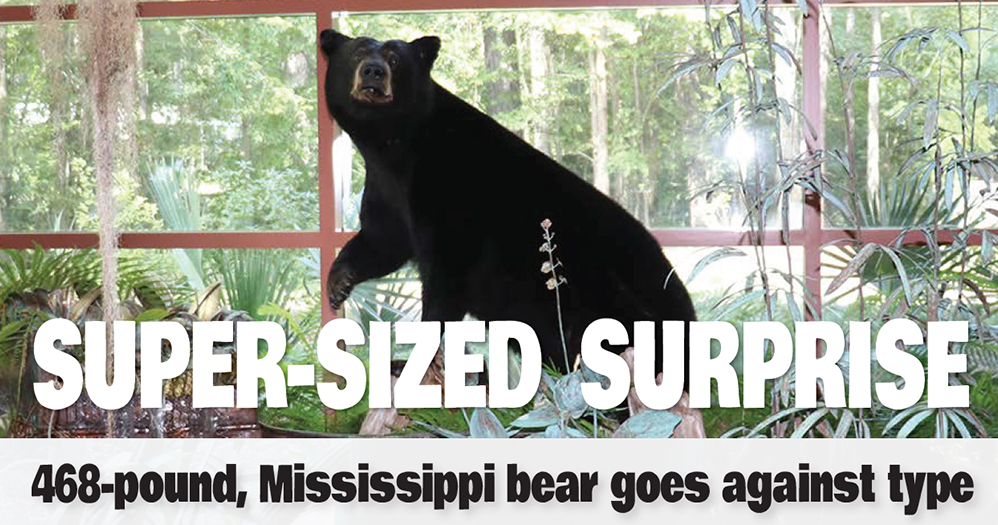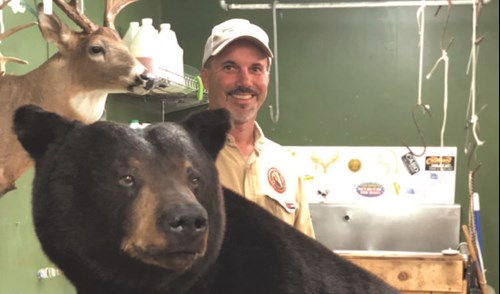Super-Sized Surprise - 468-pound, Mississippi bear goes against type
1/28/2019 10:42:49 AM
By Jamie Holt

German biologist Carl Bergmann proposed a principle in the 19th Century: Warm-blooded animals (particularly mammals) living in cold climates tend to be larger than their warm climate counterparts. There are several explanations for this pattern, such as a larger mass equals better temperature management or cold climate foods are more nutritious. All of the theories have their own scientific support. Regardless of the explanation, in most cases, Bergmann’s principle is found to be true. For example, it is widely understood that white-tailed deer in Canada are going to have more body mass than white-tailed deer in south Mississippi.
However, one thing every biologist learns is there are exceptions to the rules. Generally, bears in Mississippi range from small females in the 100-pound range to larger males that can weigh more than 300 pounds. Like most wildlife species, factors such as age, habitat quality, and genetics play a role in an adult bear’s size. With bears in particular, the time of year plays a big part in actual weight. During the late winter and early spring, bears are at their lightest weight of the year because of winter dormancy and lack of food resources. In the late fall, bears can weigh 20 percent or more than they do in spring. For example, a 200-pound bear in March might be 240-250 pounds in November.
Over the years, Mississippi Department of Wildlife, Fisheries, and Parks (MDWFP) has documented several male black bears that seem to break the mold in terms of size. One of these was first captured in Washington County in 2005, a male that weighed 275 pounds. At the time, he was nothing special in terms of size, but that same male was recaptured in Issaquena County in 2008 and 2009 weighing 377 pounds and 386 pounds, respectively. The final hands-on encounter occurred in Issaquena County in July 2012, when he was recaptured and tipped the scales at 432 pounds. At that time, he became the largest black bear documented in the state.

Andrew Stanford of Stanford Taxidermy
In 2006, MDWFP began receiving pictures of an extremely large male black bear around Highway 61 south of the Homochitto River. A few attempts were made to capture the bear to perform a workup (taking measurements, weight, blood/hair samples, and tooth extraction for age determination), but those attempts were unsuccessful. The bear almost seemed to be on a set schedule. Nearly every year around the end of March he would make his appearance on trail cameras on some of the local private properties of Wilkinson County.
Late at night on April 6, 2017, MDWFP received a call of a black bear that had been killed accidentally by a full-size sport-utility vehicle in Wilkinson County. We left early the next morning to retrieve the carcass and transport it back to the Mississippi Museum of Natural Science for examination. We do not, nor will we likely ever, have definitive proof that this is the same bear as the large male seen over the last 11 years. But based on current evidence, they are likely one and the same.
One of the first things we noticed was how large the bear was. We set up the scales to weigh it and were shocked to see the needle settle on 468 pounds, becoming the largest bear documented in the state. One thing to keep in mind is many of the other large males documented were done so in summer and fall after they had fully recovered from winter dormancy. This was early spring. It is possible that the same bear in November 2017 would have weighed close to 500 pounds. To add some perspective, I had a conversation with Jim Shockey about Mississippi bears about a year ago. Shockey, a Canadian outdoors writer, professional big-game outfitter and television producer/host for many hunting shows, hunts black bear in one of the top destinations in the world: British Columbia. During our conversation, Shockey was somewhat surprised to learn about the size some male bears reach in Mississippi.
“Wow, I would have never thought bears this far south would get that big,” Shockey said. “Even in British Columbia, 468 pounds is a pretty good-sized black bear.” The record-setting bear was sent to a taxidermist for permanent preservation and placed on display in MDWFP’s Jackson headquarters. Andy Stanford of Stan-ford Taxidermy in Saltillo completed the work as well as delivery and set up of the mount. Like most everyone else, Stanford's first reaction when he saw the bear was something similar to “oh, wow!”
Stanford said something that caught my attention when he delivered and set up the mount: “I took the measurements and started looking at forms (the foam body the hide is wrapped around for the mount) and I ordered the biggest one they had. When it came in, I had to add a lot of material to the form to make it fill out the hide. That’s when I realized how big he really was.”
The mount is a perfect addition to the cypress swamp display in the lobby of the Jackson MDWFP office. It now serves as a reminder of the unique and diverse natural resources we have in Mississippi.
Jamie Holt is a MDWFP Black Bear Program Biologist.









